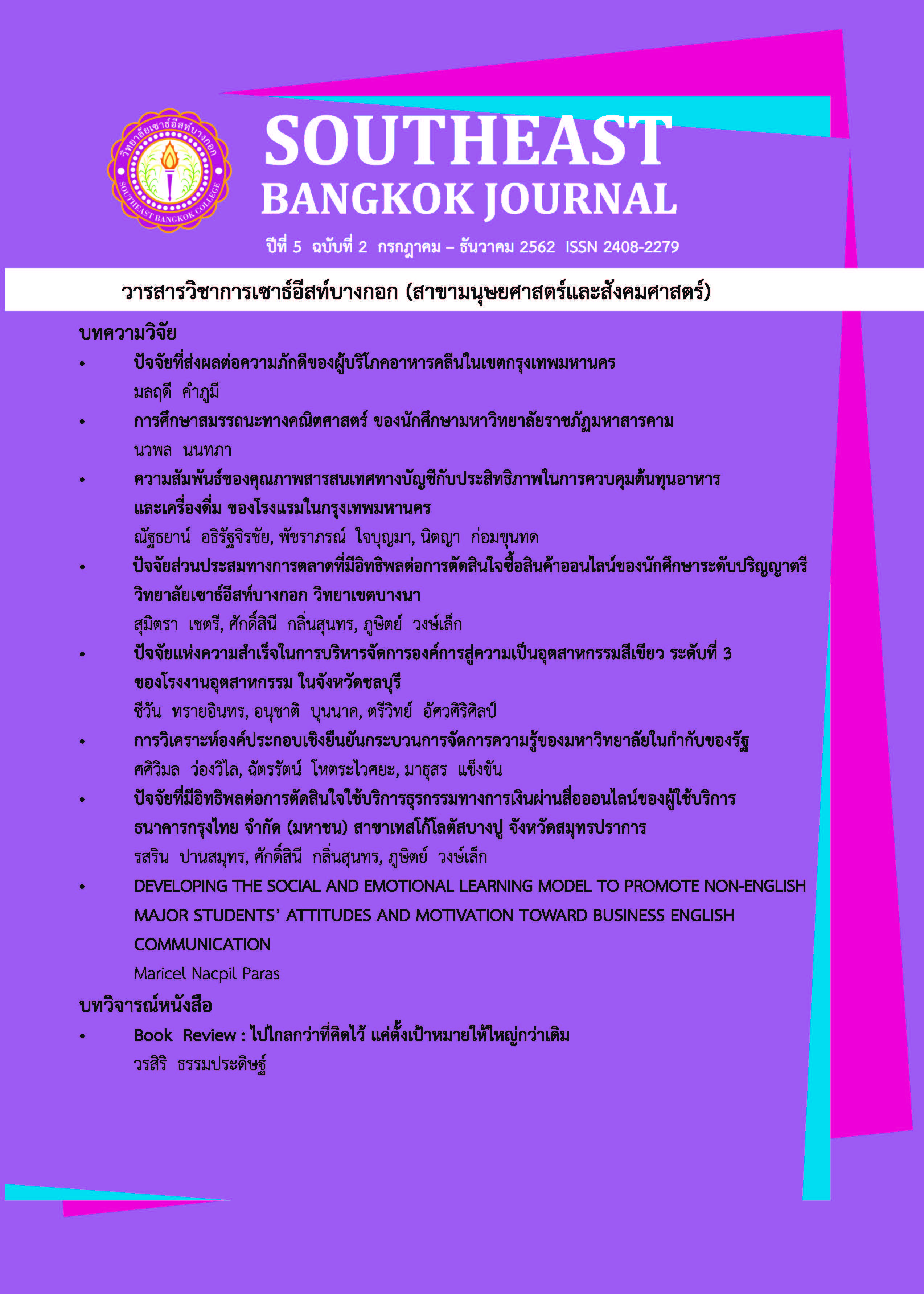CONFIRM FACTOR ANALYSIS OF KNOWLEDGE MANAGEMENT PROCESS OF AUTONOMY UNIVERSITY
Main Article Content
Abstract
The purposes of this research were to analyze confirmation factor of knowledge management process of autonomy universities. The sample group used in this research was academic support staffs affiliated with 12 autonomous universities in Thailand selected by stratified random sampling. The research instruments were the knowledge management practice questionnaire. The content validity validation has an index of consistency (IOC) between 0.60 - 1.00 and has the whole confidence value of 0.98, and the alpha coefficient reliability was 0.98. The data were analyzed using the Second – Order Confirmatory Factor Analysis for measuring how the model fitted the empirical data. The results of the research revealed that knowledge management process of autonomy universities with exploratory factor analysis (EFA) were 5 factors is knowledge Audit and Identification Factor, Knowledge Acquisitions and Creation factor, Knowledge Storage factor, Knowledge Codification and Access factor and Knowledge Transfer Learning and Assessment Factor. The result of examining the consistency of the model and empirical data using the second-order confirmatory component analysis, confirmed that the knowledge management model of the autonomous university is consistent with empirical data by 2 = 1314.803,
2/df = 1.065, df = 1234, p = 0.054, RMSEA = 0.014, RMR = 0.025, GFI = 0.889, AGFI = 0.857 and CFI = 0.996. Factor loading of latent variables were value between 0.832 to 0.974 and the most significant factor is Knowledge Transfer Learning and Assessment whereas the least significant factor is Knowledge Acquisitions and Creation. The suggestion from the research is that autonomy universities should support staffs to join the activity knowledge transfer learning with both inside and outside the university resulting in more effective knowledge management in the organization.
Article Details
References
กัลยา จุลศรี. (2552). การศึกษาสภาพการจัดการความรู้ทางการพยาบาลของโรงพยาบาลพระมงกุฎเกล้า. (วิทยานิพนธ์ปริญญาศึกษาศาสตรมหาบัณฑิต, มหาวิทยาลัยรามคำแหง).
กัลยา วานิชย์บัญชา. (2556). การวิเคราะห์สมการโครงสร้าง (SEM) ด้วย AMOS. กรุงเทพฯ: ห้างหุ้นส่วนจำกัดสามลดา.
กิตติพล มุกดาเจริญชัย. (2556). ปัจจัยที่ส่งผลกระทบต่อประสิทธิภาพการทำงานของการผลิตแบบลีนในอุตสาหกรรมยานยนต์โดยใช้โมเดลสมการโครงสร้าง. ใน การประชุมทางวิชาการมหาวิทยาลัยเกษตรศาสตร์ ครั้งที่ 51. กรุงเทพฯ: มหาวิทยาลัยเกษตรศาสตร์.
ชำนาญ เหล่ารักผล. (2553). การพัฒนายุทธศาสตร์การจัดการความรู้สำหรับโรงเรียนในเครือมูลนิธิคณะเซนต์คาเบรียลแห่งประเทศไทย. (วิทยานิพนธ์ครุศาสตรดุษฎีบัณฑิต, จุฬาลงกรณ์มหาวิทยาลัย).
นงลักษณ์ วิรัชชัย. (2542). โมเดลลิสเรล : สถิติวิเคราะห์สำหรับการวิจัย (พิมพ์ครั้งที่ 3). กรุงเทพฯ: โรงพิมพ์แห่งจุฬาลงกรณ์มหาวิทยาลัย.
บดินทร์ วิจารณ์. (2548). การพัฒนาองค์การแห่งการเรียนรู้. กรุงเทพฯ: เอ็กซเปอร์เน็ท.
บุญดี บุญญากิจ และคณะ. (2549). การจัดการความรู้จากทฤษฎีสู่การปฏิบัติ (พิมพ์ครั้งที่ 3). กรุงเทพฯ: จิรวัฒน์เอ็กซ์เพรส.
ภิญญดา อุ่นเที่ยว. (2556). ปัจจัยที่มีผลต่อการดำเนินงานตามกระบวนการจัดการความรู้ในโรงพยาบาลส่งเสริมสุขภาพตำบล จังหวัดอุดรธานี. (วิทยานิพนธ์ปริญญาสาธารณสุขศาสตรมหาบัณฑิต, มหาวิทยาลัยสุโขทัยธรรมาธิราช).
วันดี วิถี. (2554). ปัจจัยที่มีอิทธิพลต่อทักษะชีวิตของนักเรียนชั้นมัธยมศึกษาปีที่ 5 จังหวัดศรีสะเกษ ; การวิเคราะห์กลุ่มพหุ. (การศึกษามหาบัณฑิต, มหาวิทยาลัยมหาสารคาม).
วิจารณ์ พานิช. (2548ก). การจัดการความรู้ : ฉบับนักปฏิบัติ. กรุงเทพฯ: สุขภาพใจ.
วิจารณ์ พานิช. (2548ข). การจัดการความรู้คืออะไร : ไม่ทำไม่รู้. สืบค้น 21 สิงหาคม 2561, จาก http://www.swcom.mi.th/km/index.php/image-gallery/scenery/94-km/86-2013-04-29-04-24-08
สำนักโฆษก สำนักเลขาธิการนายกรัฐมนตรี. (2558). ลดเวลาเรียน เพิ่มเวลารู้ มุ่งหน้าสู่การปฏิบัติ. วารสารไทยคู่ฟ้า, (26), 14-15.
สำนักงานคณะกรรมการพัฒนาระบบราชการ. (2546). คู่มือคำอธิบายและแนวทางปฏิบัติตามพระราชกฤษฎีกาว่าด้วยหลักเกณฑ์ และวิธีการบริหารกิจการบ้านเมืองที่ดี พ.ศ.๒๕๔๖. กรุงเทพฯ: บริษัท สิรบุตรการพิมพ์ จำกัด.
สำนักงานจังหวัดตรัง. (2553). แนวทางการจัดทำแผนการจัดการความรู้ในหมวด 4 (ข.) การวัดการวิเคราะห์ และการจัดการความรู้ในปีงบประมาณ พ.ศ.2552. ใน การประชุมการชี้แจงการจัดทำแผนการจัดการความรู้ (KM Plan) ของตัวชี้วัด การพัฒนาคุณภาพการบริหารจัดการภาครัฐ ปีงบประมาณ พ.ศ. 2553 (น.12-22). ตรัง: สำนักงานจังหวัดตรัง.
Comrey, A. L., & Lee, H. B. (1992). A First course in factor analysis (2nd ed.). Hillsdale,New Jersey: Lawrence Erlbaum Associated.
Trapp, Holger. (1999). Benefits of an intranet-based knowledge management system-measuring the effect. Retrieved August 21, 2018, from http://www.avinci.de/ competence/publikationen/diplomarbeit_holger_trapp.pdf


